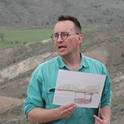Contribution to Book
Geological and geophysical perspectives on the magmatic and tectonic development, High Lava Plains and northwest Basin and Range
Volcanoes to Vineyards: Geologic Field Trips Through the Dynamic Landscape of the Pacific Northwest
(2009)
Abstract
A large part of the northwestern United States has undergone extensive late Cenozoic magmatic activity yielding one of the great continental volcanic provinces on Earth. Within this broader area lies the High Lava Plains province, the focus of this field guide. For our purposes, the High Lava Plains is a middle and late Cenozoic volcanic upland, contiguous with and gradational into the Basin and Range province to the south.
The High Lava Plains province of southeastern Oregon is characterized by thin, widespread Miocene-Pleistocene lava flows of primitive basalt and a belt of silicic eruptive centers. The rhyolitic rocks generally are successively younger to the northwest, describing a mirror image to the basalt plateau and rhyolite age progression of the Snake River Plain. The High Lava Plains is associated with a zone of numerous, small northwest-striking faults and lies at the northern limit of major Basin and Range normal faults. The abundant late Cenozoic bimodal volcanism occupies an enigmatic intracontinental tectonic setting affected by Cascadia subduction, Basin and Range extension, the Yellowstone plume, and lithospheric topography at the edge of the North American craton. The purpose of this field trip is to focus on the late Cenozoic lithospheric evolution of this region, through the lens of the High Lava Plains, by considering structural, geophysical, petrologic, and temporal perspectives.
A grand tour southeast from Bend to Valley Falls, north to Burns, and then east to Venator, Oregon, takes participants from the eastern edge of the Cascade volcanic arc, across several basins and ranges in eastern Oregon, and onto the volcanic plateau of the High Lava Plains. Day 1 provides an overview of Newberry Volcano and the western edge of Basin and Range, including the Ana River and Summer Lake fault zones. On Day 2, the early magmatic and extensional history of the region is explored along the Abert Rim range-front fault. Participants are introduced to the bimodal volcanism within the High Lava Plains, with focus on the Harney Basin and Rattlesnake ignimbrite event. An evening session will highlight geophysical results from the High Lava Plains, including new data from one of the largest active-source seismic experiments to be conducted in North America. Day 3 activities examine early bimodal volcanic history of the eastern High Lava Plains and the late Miocene and Pliocene subsidence history on the east edge of the Harney Basin east of Burns, Oregon.
Keywords
- Geology,
- Structural -- Pacific Northwest,
- Geology -- Pacific Northwest
Disciplines
- Geology and
- Volcanology
Publication Date
2009
Editor
Jim E. O'Connor; Rebecca J. Dorsey; Ian Madin
Publisher
Geological Society of America
Citation Information
Andrew Meigs, Kaleb Scarberry, Anita Grunder, Richard Carlson, et al.. "Geological and geophysical perspectives on the magmatic and tectonic development, High Lava Plains and northwest Basin and Range" Volcanoes to Vineyards: Geologic Field Trips Through the Dynamic Landscape of the Pacific Northwest (2009) Available at: http://works.bepress.com/martin_streck/15/
